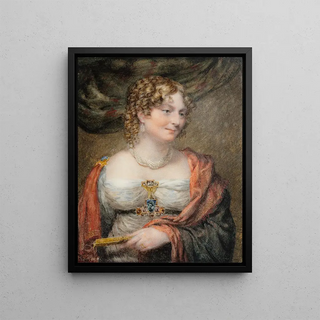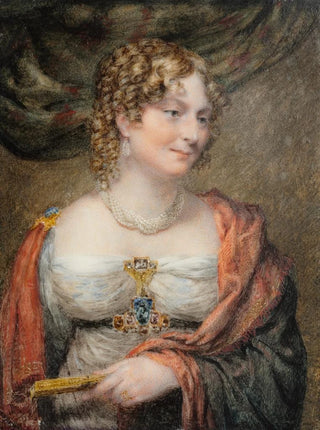Art print | Portrait of Anne Law née Towry, 1st Lady of Ellenborough - John Linnell


View from behind

Frame (optional)
Portrait of Anne Law née Towry, 1st Baroness of Ellenborough - John Linnell – Engaging Introduction
In the fascinating world of art, some works transcend mere frames to become witnesses of an era, reflections of society and the personalities that shaped it. The "Portrait of Anne Law née Towry, 1st Baroness of Ellenborough" by John Linnell is one of these memorable creations. Crafted in the 19th century, this piece evokes not only the beauty of its subject but also the elegance of a style that captured the very essence of its time. Through this portrait, Linnell does not merely depict a woman of high society but immortalizes a story, an identity, and a presence that still resonate today.
Style and uniqueness of the work
John Linnell's style is distinguished by his ability to blend realism and romanticism, a duality reflected in the portrait of Anne Law. The composition is carefully orchestrated, highlighting the delicate and expressive face of his model, while enveloping the entire piece in an atmosphere of softness and dignity. The meticulous details, such as the drapery of the dress and the light reflections on the skin, demonstrate undeniable technical mastery. Linnell manages to breathe palpable life into his subject, making the work almost interactive, as if Anne Law could step out of the painting to engage in a conversation. This ability to create an emotional connection between the viewer and the portrait is one of the reasons why this work remains so captivating.
The artist and his influence
John Linnell, born in 1792, is often regarded as a full-fledged painter of the English tradition, but his art is also imbued with romantic influences. Trained within a rich artistic environment, he succeeded thanks to his exceptional talent and sensitivity. Linnell had the opportunity to associate with prominent figures of his time, such as William Blake, whose innovative spirit undoubtedly nourished his own creativity. His approach to portrait painting goes beyond simple representation; he seeks to capture the soul of his subjects, to tell their story through their features and expressions. This

Matte finish

View from behind

Frame (optional)
Portrait of Anne Law née Towry, 1st Baroness of Ellenborough - John Linnell – Engaging Introduction
In the fascinating world of art, some works transcend mere frames to become witnesses of an era, reflections of society and the personalities that shaped it. The "Portrait of Anne Law née Towry, 1st Baroness of Ellenborough" by John Linnell is one of these memorable creations. Crafted in the 19th century, this piece evokes not only the beauty of its subject but also the elegance of a style that captured the very essence of its time. Through this portrait, Linnell does not merely depict a woman of high society but immortalizes a story, an identity, and a presence that still resonate today.
Style and uniqueness of the work
John Linnell's style is distinguished by his ability to blend realism and romanticism, a duality reflected in the portrait of Anne Law. The composition is carefully orchestrated, highlighting the delicate and expressive face of his model, while enveloping the entire piece in an atmosphere of softness and dignity. The meticulous details, such as the drapery of the dress and the light reflections on the skin, demonstrate undeniable technical mastery. Linnell manages to breathe palpable life into his subject, making the work almost interactive, as if Anne Law could step out of the painting to engage in a conversation. This ability to create an emotional connection between the viewer and the portrait is one of the reasons why this work remains so captivating.
The artist and his influence
John Linnell, born in 1792, is often regarded as a full-fledged painter of the English tradition, but his art is also imbued with romantic influences. Trained within a rich artistic environment, he succeeded thanks to his exceptional talent and sensitivity. Linnell had the opportunity to associate with prominent figures of his time, such as William Blake, whose innovative spirit undoubtedly nourished his own creativity. His approach to portrait painting goes beyond simple representation; he seeks to capture the soul of his subjects, to tell their story through their features and expressions. This






